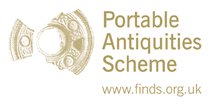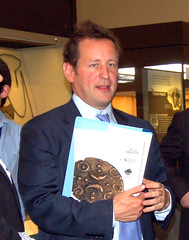Server check!
You are on the training database
Annual report 2008
The main achievements of the Portable Antiquities Scheme (PAS) and the Treasure Act 1996 in 2008 can
be summarised as follows and you can download the full copy in PDF format.
The extent of the PAS and the Department of Portable antiquities and treasure
A network of 40 Finds Liaison Officers (FLOs), several of which are part-time posts, cover the whole of England and Wales. Their work is co-ordinated and supported by a central unit consisting of a Head and Deputy Head, Resources Manager, ICT Adviser (based at the British Museum) and six Finds Advisers. Also employed within the Department of Portable Antiquities and Treasure, is a Treasure Registrar and four Assistant Treasure Registrars. In 2008, in addition to the finders who recorded finds with the PAS, at least 127 people volunteered with the Scheme.
Recognition of success
In November 2008 "A Review of the Portable Antiquities Scheme" found the PAS to be both efficient and cost-effective. The Staffordshire Hoard (reported Treasure via the PAS) won 'best archaeological discovery' in the British Archaeological Awards 2010, and is a credit to all those involved with its discovery, research and the public dissemination. The PAS database was shortlisted as 'best archaeological innovation' in the same awards. Finds recorded through the PaS: In 2008, a further 53,346 archaeological objects have been recorded by the PAS (and published on its database); some of these are illustrated in this report. Of these, at least 87% have been discovered by people while out metaldetecting; the rest have been found by other means.
Finds reported treasure
806 cases of Treasure were reported in 2008 (some of these cases include multiple items). This figure continues to increase; the rise being most notable since 2003, when the PAS was expanded to cover the whole of England and Wales, since when there has been an average increase of almost 210% in the reporting of potential Treasure finds. Most cases (93.28%) have been discovered while metal-detecting.
acquisition of treasure: 265 new Treasure finds have been, or are being, acquired by museums, while
366 have been disclaimed, 139 were deemed not to be Treasure and 33 are still to be determined. The outcomes of all 2008 Treasure cases are given in the Treasure Annual Report 2008.
As in previous years, museums have received help to enable them to acquire Treasure from the Art Fund V&A/MLA Purchase Grant Fund, the Headley Museums Treasure Acquisition Fund, the National Heritage Memorial fund and the Heritage Lottery Fund, without which many finds would not have been acquired.
Donations
In 2006 the DCMS launched an initiative to encourage finders and landowners to consider waiving their rights to rewards in order that museums are more able to acquire Treasure finds; certificates, signed by the Minister, are given to those who do so. In 2008 there were 51 (6.35%) cases where one or both parties (82 individuals in all) waived their rewards.
Findspot information
Over 92% of PAS finds have been recovered from cultivated land, where they are susceptible to plough damage and artificial and natural corrosion processes. Over 89% of finds are now being recorded to the nearest 100m2 (a six-figure National Grid Reference) or better, and over 42% of finds are being recorded to the nearest 10m2(an eight-figure National Grid Reference).
Finds data
The finds data generated by the PAS is made available to Historic Environment Records (HERs) - the key record holders for information about the historic environment - and is published on the Scheme's website: www.finds.org.uk. A protocol has been agreed on the transfer of PAS data to HERs, which more than two-thirds have now signed. New sites discovered: Many important new archaeological sites have been discovered as a result of the finds recorded by the FLOs or reported Treasure, including, a prehistoric flintworking site in Oxfordshire (5) and an Anglo-Saxon burial site in East Sussex (p. 18).
Research
New research is showing that PAS data has the potential to radically alter our understanding of the historic environment and further archaeological knowledge. Currently 198 people, including academics
and professionals, have full access to PAS data for research purposes. PAS data has been used in the course of seven major research projects (such as those funded by the Arts & Humanities Research Board or Leverhulme Trust), 32 PhDs, 46 MA dissertations and 20 undergraduate research projects.
Publications
Several publications associated with the work of the Scheme have appeared in 2008, including the Portable Antiquities sections of Britannia 39, Medieval Archaeology 52, and Post Medieval Archaeology 42.
Outreach
1,637 outreach events, including talks, finds days and exhibitions, were organised in 2008; these were attended by at least 50,032 people, including 7,667 children. At least 215 articles about the work of the PAS were published or broadcast, including academic publications, articles in the popular press, and reports on television and radio. As part of National Archaeology Week 2008, the PAS was involved in 73 events, attended by at least 5,093 adults and 2,373 children, and its FLOs examined more than 2,967 finds.
Liaison
During 2008 the FLOs maintained regular contact with 170 metal-detecting clubs - attending 727 club meetings, and they also liaised with local archaeological and history groups. Members of the Scheme attended at least 922 other meetings to promote the Scheme and its aims.
Social inclusion
In 2006 a socio-economic analysis of postcode data showed that 47% of people recording finds with the Scheme (since 1997) were from groups C2, D and E, which compares favourably to visitors to
museums (31%).
Website
There have been almost 185,000 unique visitors to the PAS website - www.finds.org.uk - making over 306,000 visits and 3,771,000 page requests during 2008. The average number of page requests per visit is 11. At the time of publication the online database allows public access to 675,535 objects within
425,045 records.
Heritage protection
In 2008 the Department of Portable Antiquities and Treasure, at the British Museum continued to monitor eBay for finds of unreported Treasure. Intelligence on 181 cases was passed to the police. Since September 2007 the Department has been an expert adviser on the export licencing of metal detected finds, and in the period of this report approved 278 licences, of which more that 82% were exported outside the European Union. The PAS was a partner in Oxford Archaeology's Nighthawking Report, and is working with English Heritage to take its recommendations forward.
The PAS works closely with relevant colleagues in HM Revenue & Customs, the MLA Exporting Unit, and since February 2007 Michael Lewis (Deputy Head) has been seconded (part-time) as a Special Police Constable with the Metropolitan Police Service's Art & Antiques Unit.



